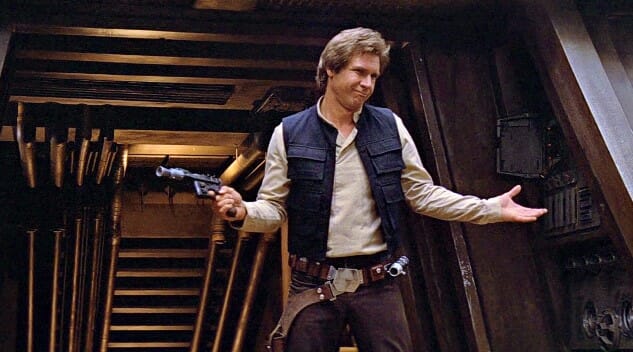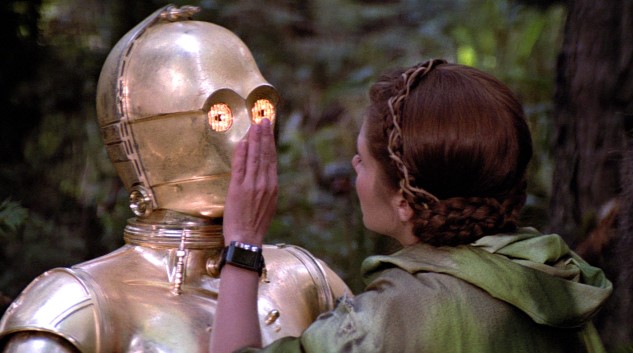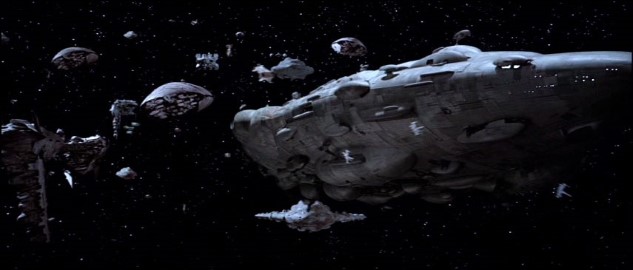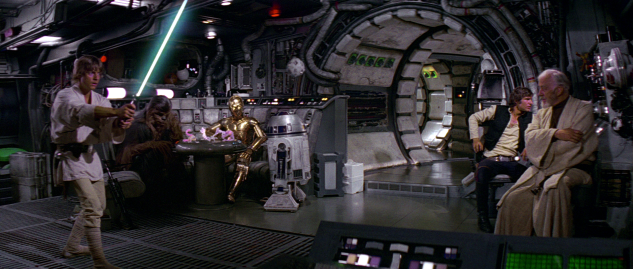
At the end of the day, Star Wars movies are fantasy films. Or westerns. Or samurai pictures. They’re a whole lot of things—but they barely qualify as sci-fi. Simply having a spacey setting isn’t really enough to earn that distinction.
Star Wars is the softest of science fiction, especially compared to the likes of Star Trek, a series in which its writers spent far more time tinkering with the background of the world and “how things work.” Ask an intense Star Trek fan questions about how some piece of technology works within that universe, and they can probably give you an answer that is at least logically consistent. The technology of Star Wars, on the other hand, is all smoke and mirrors, with explanations that directly contradict other explanations. Even in the expansive fiction of the former Extended Universe, these are issues that are for the most part only grazed, rather than examined in depth.
And that’s fine. Science isn’t what Star Wars is all about. This is a series about mysticism, light vs. dark, things going boom, not how mankind and other spacefaring races grapple with the ethics of technology and science. I’m not claiming that Star Wars should be explaining any of these things—just pointing out the humorous nature of how many things we’re happy to accept as unexplained. It’s a pulp series, so the true reason for any of the things that don’t make sense about the galaxy just becomes “Because it serves the narrative,” much as your dungeon master is likely to fall back upon “A wizard did it!” in your D&D game.
In that spirit, here are five technological/scientific aspects of the Star Wars universe that you may never have considered before.
Impossibly fast travel

The original Star Wars trilogy actually does a great job of avoiding direct questions around “hyperspace issues” by leaving just enough reasonable doubt to invalidate any questions you might have. You can ask, “How does Luke get from Dagobah to Cloud City so quickly?” or, “How do they get from Tatooine in the Outer Rim to a core world like Alderaan so fast?”, but in every such scenario in the original trilogy the logical answers are always “Well, we don’t know how long ____ really took.” For all we know, the Millennium Falcon’s journey to Cloud City took weeks. Or perhaps Han, Leia and co. spent significantly more time hanging out with Lando than we realize. The point is that we don’t know, because specific time frames are never given in these situations. This protects the internal logic of light speed travel, because even traveling at “point five past light speed” or what have you, the almost incomprehensible gulfs between star systems are simply not the kinds of distances that can be crossed in minutes, hours or even days.
To cite a canonical Star Wars roleplaying game, which uses the official size of the Star Wars galaxy, 120,000 light years in diameter:
Even with a well-traveled hyperspace route, the fastest ships, such as the Millennium Falcon, would take several months to traverse the whole diameter of the galaxy.
So there you have it. Internally consistent, right? Well yeah, up until the latest films, The Force Awakens and Rogue One, which threw these concepts completely out the window in the name of adding more action set-pieces. Rogue One in particular does such a good job of dismantling the logic of hyperspace travel that you’d almost believe it was purposely setting out to do so. To whit:
1. The commando team led by Jyn Erso and Cassian Andor lands on the planet Eadu to either extract or kill Jyn’s father, Galen. While there, a message is broadcast from their ship to the rebel base on the moon of Yavin IV, traveling back and forth through space instantaneously, which is of course also impossible. The rebel base dispatches bombers to travel via hyperspace from Yavin IV to Eadu to carry out the bombing and kill Galen.
2. Those fighters arrive at Eadu while the same scene is still playing out in which they were called, which is to say: There’s no wiggle room for “missing time” here. At the most, they arrive maybe 30 minutes after the call is sent out.
3. Therefore, those fighters somehow traveled from one planetary system to another in 15-30 minutes. That is some absurdly, world-breakingly fast travel right there. You can thank Rogue One’s screenwriters for making you look at the Star Wars galaxy like it’s the size of a child’s backyard sandbox from now on. This one small change affects the internal logic of the entire series—imagine Luke on Dagobah, agonizing over whether he should go save his friends…who are a 20-minute hyperspace ride away.
Practically every planet is fit for human life

The Star Wars series loves to zip from planet to planet (Rogue One alone is all over the place in the first 30 minutes), but have you ever noticed that nearly every planet in their universe falls within the extremely narrow “Goldilocks zone” that is habitable for humans? And it’s not just “there’s food and water available” either. Almost every planet has:
A. A breathable atmosphere that requires no respirator or any kind of filtration
B. A galactically consistent strength of gravity, or close enough as to make no difference
The latter is a particularly big coincidence, as we consistently see planets implied to be either far more or less massive than “Earth,” which would thus logically have different strengths of gravity, and yet none of the film characters are ever affected. Even in cases where Extended Universe fiction makes a point of saying that a celestial body has a lower gravitational strength, such as on the Forest Moon of Endor, there’s not a whiff of implication of this in Return of the Jedi.
The atmosphere question, meanwhile, is touched upon in the briefest, barest of fashions. We get quick glimpses of aliens such as the bounty hunter Zuckuss (in Empire Strikes Back), an insectoid Gand who needs to breathe an ammonia-based atmosphere to survive, which at least confirms the idea that there do exist planets out there unsuitable to human life. But we never really see any of them, and even when visiting planets where humans aren’t the native civilization, such as Kashyyyk or Geonosis (which is noted on Wookieepedia as having “light gravity”—no indication of that in the film, guys!), we find planets that just so happen to have atmospheres perfectly suitable for human life. Guess which kind of planet might have made for a more secure site for building an anti-human droid army? One where humans can’t breathe the air would have been a nice baseline security feature. Heyo, I must be some sort of tactical genius!
It all points toward one of the universal truths of Star Wars: This whole galaxy seems explicitly designed for humankind, for whatever reason. There are hundreds, if not thousands of other sentient, spacefaring races, but humans are by far the most common and widespread, and the elements themselves cater to their whims…or vice versa. It’s a chicken and egg scenario, but it’s funny to consider. Even on planets where they didn’t evolve or colonize, humans of the Star Wars universe find their every physiological need catered to. It’s actually a pretty sweet place for your average human to live.
Every language translation comes from a sentient robot

Look to The Hitchhiker’s Guide to the Galaxy for a moment. When writing it, Douglas Adams wanted to feature a variety of alien races, but he wanted all of his characters to be able to communicate freely with one another, for the sake of humor. So how did he manage this? The answer is that he invented a device, the “babel fish,” which is a universal translator that fits within one’s ear. This simple plot device solves the problem of characters being unable to understand one another.
Star Wars handles this problem differently—much differently. In the Star Wars universe there doesn’t seem to be such a thing as translation software, or any kind of hand-held translation device. Either you speak/can understand an alien language, or you hope they can understand Basic, which is the galactic standard that fills in for English (another facet of a human-run universe).
The other option is a protocol droid, or a droid who otherwise serves as a translator, but these are, how shall we say, insanely impractical the more you think about them. Instead of being able to use a handheld (or better yet, implanted) translation device in your dealings with the local Sullustan or Rodian mining guild, you’re instead stuck using a whining, anxious, neurotic protocol droid who more often than not chooses to use its full sentience to criticize every move that you make. Stop and consider C-3PO’s actual personality for a moment. This is a typical PROTOCOL droid, designed for interpretation and politeness, but he spends most of his time bitterly lamenting his lot in life and generally being a sad sack.
Why do all of these droids universally have sentience, anyway? Whose decision was it to make all of these droids, be they interpreters or astromech units (like R2-D2), sentient beings with free will and distinct personalities? What kind of cruel world is this, where you build millions of robots to toil as servants, but then go out of your way to make sure they’re aware of their lower station within society? For Christ’s sake, Why can these robots feel physical pain? The more you think about it, the more nightmarish the whole concept becomes.
One thing is clear: Droidhood is no picnic, and owning a cantankerous droid for a task as basic as interpretation is little better. This is also fuel for the popular “everyone in the Star Wars galaxy is functionally illiterate” fan theory.
Galactic Standard “Down”

This is a common trope of science fiction depictions of spacecraft in general. Suffice it to say, there is no natural “up” and “down” once you escape the atmosphere of a planet, and the orientation of a ship in orbit above a world has no default direction.
However, because the audience isn’t used to imagining space in this way, space battles in Star Wars are largely streamlined to put all of the ships—especially the capital ships—onto a “level field” with one another. Look at the final space battle in Return of the Jedi, for instance: Both fleets, the rebels and the Imperials, all line up their capital ships with the exact same arbitrary “downward” direction. Only the small fighters seem to be occasionally able to discover the existence of the Y-axis, to approach from “above” or “below.” Even when opposing fleets have no idea from what direction the other might be approaching, they just so coincidentally happen to end up oriented in the same way. As a result, you never see any “upside down” star destroyers closing in on the rebel fleet, or vice versa. This, despite the fact that there is no such thing as “upside down” in space. Even the common shorthand of putting the nearest planet “below” the position of the fleet doesn’t really mean anything, other than giving the audience a point of reference that simply “feels” right.
The reality is that Star Wars pictures travel through space very much like we would picture travel through the air on our own world. Space fighters are like fighter aircraft, nimble and able to maneuver. Capital ships are battleships on the sea, except suspended in the air like war zeppelins. I won’t even bother going into the scientific difficulties presented by the way they move in space. That’s worthy of an entire dissertation of its own. For the purposes of this list, their conveniently default orientation in space is more than enough.
Standard, infallible artificial gravity

This goes along with the last entry, because in addition to always being oriented with a default “down” below them (such as a planet), every starship in the Star Wars galaxy also seems to come equipped with perfectly functioning, always-present artificial gravity generation. I mean really, think about it: Everyone is able to stroll around every ship with the same (always standardized) gravity that seems to exist on every Star Wars planet, regardless of the size or sophistication of the ship.
This is one of those technological issues they probably could have established with a line or two of dialogue, but nowhere in the films (or in any of the Extended Universe tomes I read as a child) is this particular bit of tech ever mentioned. However it works, it’s able to keep the people in the ship oriented to the floor, no matter the ship’s positioning in space. Even when flying through the atmosphere of a planet with its own gravity, the artificial gravity present on a ship such as the Millennium Falcon seems to be able to keep everyone sitting comfortably in their seats when pulling off insane maneuvers or flying upside down. Just look at Rey and Finn during the first Falcon scene on Jakku in The Force Awakens—neither has any kind of harness keeping them in their seats, but they’re totally unaffected by everything from upside down flying to complete freefall. It’s worth noting that oddly (and inconsistently), in the same scene, BB-8 is bumping all over the place. The hell?
Even when ships of the Star Wars galaxy are heavily damaged, the artificial gravity never fails. It doesn’t matter what kind of pounding the Falcon is taking—fires breaking out, asteroid impacts, hyperdrive shot, etc.—we never see all of its occupants suddenly floating around, trying to keep the ship together. The artificial gravity systems are unconquerable.
Jim Vorel is a Paste staff writer and resident Star Wars geek. You can follow him on Twitter for more film nerdery.